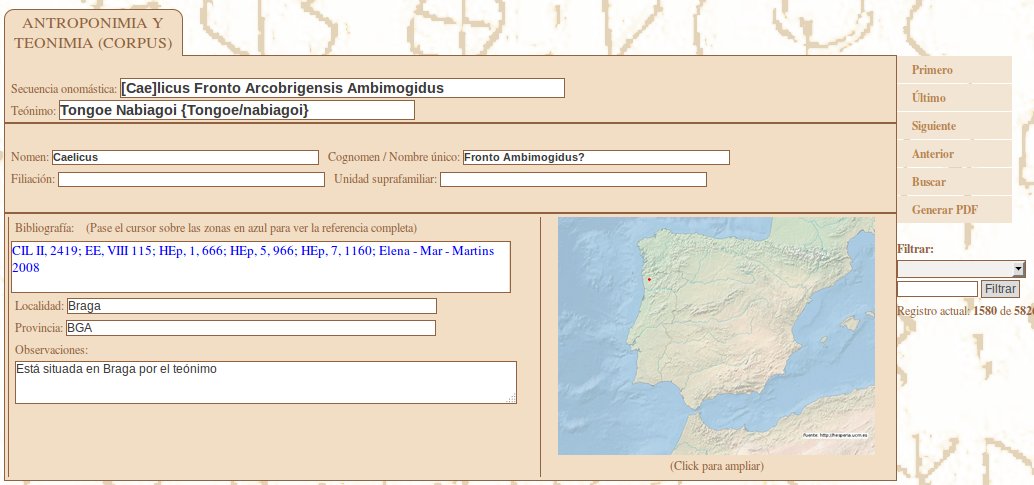Onomastics
An external view of an onomastics page (click to enlarge):

The onomastics page is divided into five tabs: "Anthroponomy and Theonomy (Corpus)", "Anthroponomy (Analysis)", "Theonomy (Analysis)", "Toponymy" and "Ethnonymy", the first three being interrelated.
The "Anthroponymy and Theonomy (Corpus)" page contains some 5800 records of individual names which contain at least one element of indigenous origin (either a personal name or patronym). Also included are dedications to indigenous deities. An individual, for example, whose name contains two indigenous elements and who has made a dedication to a divinity will appear in one record only, with all the onomastic elements noted, as well as the bibliography relevant to its identification and information on its location, plus a small map based on geographical coordinates that also enable general distribution maps to be created in other tabs.
- The anthroponomy includes
- indigenous names from Hispania in Latin and local epigraphy.
- indigenous names from Hispania which appear in literary sources.
- indigenous names from Hispania in Latin epigraphy found outside the Iberian Peninsula.
- The theonomy includes
- indigenous names of divinities in the Iberian Peninsula, in Latin and Palaeohispanic inscriptions.
The database is based on general epigraphic and onomastic corpora, with a clear starting point in the work of Abascal 1994b, which collects the personal names in Latin inscriptions in the Iberian Peninsula. To this work data have been added from other works, such as the Atlas antroponímico de la Lusitania romana (Grupo Mérida 2003) and Vallejo 2005 (which deal with the Roman province of Lusitania); Vallejo 2009c (which provides updated data for ancient Gallaecia); Vallejo 2013a (for updated information on Asturia); Gorrochategui et alii 2007 (for the region of the Vaccaei); Navarro et alii 2011 and Gorrochategui & Vallejo 2014 (for Celtiberia); Untermann, MLH III.1, 207-238, Moncunill 2010 and Rodríguez Ramos 2014 (for Iberian names); and Gorrochategui 2006, 2007 and Fernández Palacios 2009 (for the Vascones).
For the theonomy, collections such as those by Encarnação 1975, Garcia 1991, Prósper 2002 and Olivares 2002, have been taken into account.
The periodic revisions that Hispania Epigraphica makes for the epigraphy of the Iberian Peninsula are fundamental for the anthroponomy and theonomy sections, and as such are taken as the main source for updates to the database. Similarly, the Année Épigraphique is used to update the Imperial Latin epigraphy, and the Chronicae in the jounal Palaeohispanica which periodically features news on local epigraphy of Hispania.
In the future a further two tabs will open up, "Anthroponomy (Analysis)" and "Theonomy (Analysis)", with separate tables that include linguistic analyses and distribution of each of names (personal and those of divinities) currently in the Corpus of the first tab.
The "Toponymy" tab will contain the names of place which appear in the Classical literary sources and in inscriptions. Each entry will provide a linguistic analysis of the toponym and a discussion of its location. The "Ethnonymy" tab will collect the names of ethnic groups and peoples which appear in inscriptions and in literary sources.
The content of the onomastic database will constitute Volume III of the HESPERIA Palaeohispanic Database, which will be available from the Publishing services of the University of the Basque Country (UPV/EHU).
© 2005 Departamento de Filología Griega y Lingüística Indoeuropea · Universidad Complutense de Madrid
License Data Bank last update: 2025-12-14 12:33:41